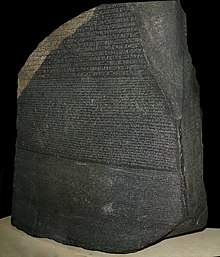
Back Parallelle teks Afrikaans Corpus paral·lel Catalan Paralelní korpus Czech Corpus paralelo Spanish Corpus paralelo Basque Concordancier multilingue French 병렬말뭉치 Korean Tekst równoległy Polish Corpus paralelo Portuguese Битекст Russian

This article needs additional citations for verification. (May 2008) |
A parallel text is a text placed alongside its translation or translations.[1][2] Parallel text alignment is the identification of the corresponding sentences in both halves of the parallel text. The Loeb Classical Library and the Clay Sanskrit Library are two examples of dual-language series of texts. Reference Bibles may contain the original languages and a translation, or several translations by themselves, for ease of comparison and study; Origen's Hexapla (Greek for "sixfold") placed six versions of the Old Testament side by side. A famous example is the Rosetta Stone, whose discovery allowed the Ancient Egyptian language to begin being deciphered.
Large collections of parallel texts are called parallel corpora (see text corpus). Alignments of parallel corpora at sentence level are prerequisite for many areas of linguistic research. During translation, sentences can be split, merged, deleted, inserted or reordered by the translator. This makes alignment a non-trivial task.
Parallel texts may be used in language education.[3]
- ^ Chan, Sin-Wai (2015). Routledge Encyclopedia of Translation Technology. London: Routledge. ISBN 978-1-315-74912-9.
- ^ Williams, Philip; Sennrich, Rico; Post, Matt; Koehn, Philipp (2016). Syntax-based Statistical Machine Translation. Morgan & Claypool. ISBN 978-1-62705-502-4.
- ^ Abdallah, A. (2021). Impact of using parallel text strategy on teaching reading to intermediate II level students. International Journal on Social and Education Sciences (IJonSES), 3(1), 95-108. https://doi.org/10.46328/ijonses.48
© MMXXIII Rich X Search. We shall prevail. All rights reserved. Rich X Search